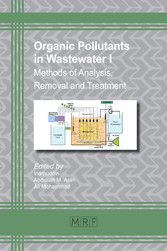Suchen und Finden
frontpages
2
Table of Contents
6
1. Introduction
10
2. Features of magnetic solid phase extraction (MSPE)
11
2.1 Magnetic sorbent materials
12
2.2 Synthesis and characterization of magnetic sorbents
15
3. Overview of magnetically responsive bio-sorbents
19
3.1 Mechanism of magnetic biomaterial modifications
20
3.1.1 Magnetic fluid modification
20
3.1.2 Microwave aided magnetic modification
21
3.1.3 Mechano-chemical magnetic modification
22
4. Application of magnetically responsive bio-sorbents
23
4.1 Magnetically responsive biopolymer
25
4.2 Magnetically responsive plant derivatives
26
4.3 Magnetically responsive microalgae
27
4.4 Magnetically responsive activated carbons
32
4.5 Magnetically responsive microbial cells
34
5. Conclusions and future outlook
37
References
38
2
50
1. Introduction
51
2. Material and methods
52
2.1 Chemical and reagents
52
2.2 Treatment process
52
2.3 Analytical procedures
53
2.4 Statistical analysis
53
3. Results and discussion
53
3.1 Effect of pH
53
3.2 Effect of contact time
57
3.3 Effect of Fe+2 dose
57
3.4 Effect of H2O2 concentration
60
3.5 Effect of initial dye concentration
60
3.6 Effect of temperature
60
3.7 Effect of UV radiation
64
4. Kinetic modeling
66
5. Degradation, water quality and cytotoxicity of effluents
68
6. Conclusions
71
References
71
3
75
1. Introduction
76
2. Materials and methods
77
2.1 X-Ray diffraction
78
2.2 X-Ray photoelectron spectroscopy
81
2.3 Transmission electron microscopy (TEM)
84
2.4 UV –Visible spectroscopy
85
2.5 Photocatalytic activity
86
4. Conclusions
91
Acknowledgement
91
References
91
4
96
1. Introduction
97
1.1. Use of raw biomass as biosorbents
99
1.2 Mechanism of biosorption
102
2. Physicochemically treated biomass and their adsorption characteristics
104
3. Use of charred biomass
107
3.1 Production of biochar
108
3.2 Characteristics of biochar for adsorption
111
4. Conclusion
118
References
118
5
131
1. Introduction to carbon quantum dots
132
2. Structure of carbon quantum dots
133
3. Synthesis of carbon quantum dots
133
3.1 Top-down approach
134
3.1.1 Electrochemical method
134
3.2 Bottom-up approach
134
3.2.1 Hydrothermal method
135
3.2.2 Microwave method
136
3.3 Synthetic methods
137
4. Properties of carbon quantum dots
139
4.1 Optical
139
4.2 Biologically compatible
139
5. Applications of carbon quantum dots
139
5.1 Chemical sensing
139
5.2 Photocatalysis
140
5.3 Bioimaging
141
5.4 Drug delivery
142
6. Degradation of organic pollutants using carbon quantum dot based composites
143
7. Conclusions
145
References
145
6
157
1. Introduction
158
2. Methods of determination of Phenols
160
2.1 Physical methods
161
2.1.1 Solvent extraction
161
2.1.2 Liquid-liquid extraction
161
2.1.3 Three Phase Liquid System
162
2.1.4 Pervaporation
164
2.1.5 Membrane filtration
164
2.1.5.1 Reverse osmosis separation methods
164
2.1.5.2 Ultrafiltration
165
2.1.5.3 Nanofiltration
165
2.1.6 Adsorption
166
2.1.7 Cloud point extraction method
167
2.2 Chemical methods
168
2.2.1 Advanced oxidation process
168
2.2.2 Air oxidation
168
2.2.3 Catalytic wet air oxidation of phenol
168
2.2.4 Photodecomposition
168
2.2.5 Coupled ultrasound and Fenton’s reagent
171
2.2.6 Three phase electrode system
171
2.3 Biological Methods
173
2.3.1 Enzymatic degradation
173
2.3.2 Microbial degradation
177
3. Conclusions
180
References
180
7
191
1. Introduction
192
1.1 Advanced oxidation processes (AOPs)
193
1.2 Principle of heterogeneous photocatalysis
193
1.3 Semiconductor photocatalysts for water splitting
194
1.4 Applications of semiconductor photocatalysts
196
1.5 Modified TiO2 photocatalysts
198
1.6 Application of modified TiO2 photocatalysts
199
1.6.1 Metal loaded TiO2
199
1.6.2 Non-metal loaded TiO2
200
1.6.3 Metal halide loaded TiO2
202
1.7 Bismuth-based photocatalysts:
203
1.7.1 BiOBr Semiconductors
203
1.7.2 Bi2S3 semiconductors
203
Conclusions
204
References
204
8
215
1. Introduction
216
2. Features of oxide semiconductors for photocatalysis
217
3. Zinc oxide nanomaterials as photocatalyst
219
4. Titanium oxide nanomaterials as photocatalyst
223
5. Iron oxide nanomaterials as photocatalyst
226
6. Cerium oxide nanomaterials as photocatalyst
229
7. Conclusions
231
References
232
9
247
1. Introduction
248
2. Photocatalytic ZnO/graphene composites
249
2.1 ZnO/graphene composites
250
2.2 ZnO/reduced graphene oxide composites
251
3. Photocatalytic ZnO/carbon nanotube based semiconductor composites
254
4. Photocatalytic ZnO-silica, alumina, zeolite and clay based composites
257
5. Photocatalytic ZnO-luminescent agent based composites
260
6. Photocatalytic ZnO-transition metals, rare earth metals, and non-metals based composites
263
6.1 Transition metals-doped ZnO composites
263
6.2 Rare earth metals-doped ZnO composites
265
6.3 Non-metals-doped ZnO composites
266
7. Conclusion
267
References
267
10
282
1. Introduction
283
2. Heterogeneous photocatalysis
284
2.1 Titanium dioxide as photocatalyst
285
2.2 Electronic structure of TiO2
285
2.3 Physical properties of TiO2
285
2.4 Mechanism of TiO2 assisted heterogeneous photocatalysis
287
2.5 Modification of TiO2 photocatalysts
289
2.6 Nanocomposites and their classification
290
3. TiO2 based nanocomposites for photocatalytic degradation of organic pollutants
290
3.1 Organic Polymer based TiO2 nanocomposites for degradation of organic pollutants
290
3.2 Inorganic Polymer based TiO2 nanocomposites for degradation of organic pollutants
292
3.3 Metal oxide-based TiO2 nanocomposites for degradation of organic pollutants
293
3.4 Noble metal/ carbon-based TiO2 nanocomposites for degradation of organic pollutants
295
Conclusions
295
References
296
11
303
1. Introduction
304
2. Industrial pollutants and their impact on water
305
3. Treatment technologies
308
4. Agro industrial wastewater
310
4.1 Olive mill wastewater
310
3.2 Palm oil mill wastewater
320
3.3 Dairy industry
325
3.4 Tomato-processing wastewater
331
3.5 Fish-processing wastewater
331
3.6 Distillery wastewater
333
3.7 Molasses spent wash
333
3.8 Winery wastewater
336
Conclusions
343
References
343
keyword index
360
about the editors
361
Alle Preise verstehen sich inklusive der gesetzlichen MwSt.







